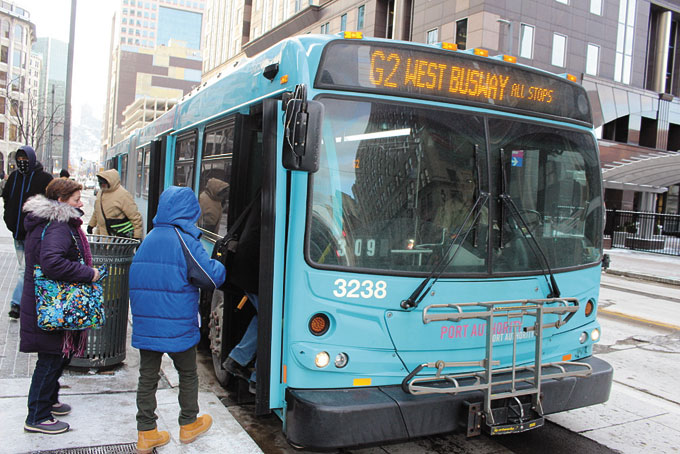
Though changes in the Port Authority of Allegheny County’s fare system went into effect Jan. 1, most commuters didn’t experience them right away because, for them, Monday, Jan. 2 was a holiday.
By many accounts, Jan. 3 was anything but.
One such commuter on the 14 Ohio Valley bus was perfectly fine until—thanks to new rules requiring “pay-enter” at the front door, and exit at the back—he had to exit in the rear. Unfortunately, his bicycle was still lashed to the front of the bus when it pulled away. Luckily, he got the driver’s attention and didn’t have to run to the next stop.
One driver on the 51 Carrick route said while pay-enter does deter the freeloaders, the rear-exit can be a problem, especially at night and for elderly riders.
“I could be letting someone off in a snow drift, or on a hill,” he said. “That should just be for Downtown stops only.”
That policy is also creating longer waits for buses during the evening outbound rush–and obviating the advantages of the longer segmented buses to take on a lot of passengers at once. Such delays are further exacerbated when long lines of riders have to wait for one or more wheelchair users, and cash customers.
The T system is now entirely cashless. But cash customers on PAT buses have their own set of complaints; mainly that––with the elimination of paper transfers––they are being shafted.
Under the old system, if someone wanted to ride from the New Pittsburgh Courier offices into Downtown for a quick errand, they could pay $2.50 for the ride and $1 for a transfer, with the round trip cost being $3.50. Now, cash riders pay $2.75 for each trip adding up to $5.50.
The flip side is that riders using Connect Cards still ride for $2.50 and can get a $1 transfer––they can also load the cards with a set amount of money or buy monthly, weekly and even $7 daily passes.
And with the elimination of the 2-zone fare system, long commute riders get a substantial discount on passes––$25 per week instead of $37.50. The cash penalty was designed in an effort to force bus riders to use the connect card system. But until the Authority has more retail locations and more kiosks at stops where customers can get and load the cards, low-income cash customers––about 20 percent of PAT’s ridership––will continue to pay more.
Ilea Washington, who rides from Homewood to her job at 7-11 on Liberty Avenue, isn’t happy about it.
“I guess it’s good because people can’t bypass the bus for free, but it’s bad because you’re paying $5.50 for a ride that used to be $3.50.It’s hard enough for me to get on the bus as it is,” she said. “Not everybody has access to Connect Cards where they live, and without paper transfers, you’re messing with money that shouldn’t be messed with. I mean times are hard. I don’t think it was thought out very well.”
Authority spokesman Adam Brandolph said another problem that arose that first day was that people who had paper tickets–good for one- and two-zone rides––hadn’t exchanged them for credit on Connect Cards, despite being told for months they could not be used beginning Jan. 1.
‘People were lined up out the door and onto the sidewalk (at the Service Center on Smithfield Street),” he said.
David Cook, a retired chef from Ingram, said he thinks the changes are good.
“Pay-enter at the front is good because people getting in on the back tend to get over on the bus drivers––if they get on in front, you can tell if they pay or not,” he said. But I think it does hurt low-income people who can’t get a connect cards. Overall, I like the changes. I think they’re good. The best part is having one zone for everything—it saves people money.”
Like us at https://www.facebook.com/pages/New-Pittsburgh-Courier/143866755628836?ref=hl
Follow @NewPghCourier on Twitter https://twitter.com/NewPghCourier